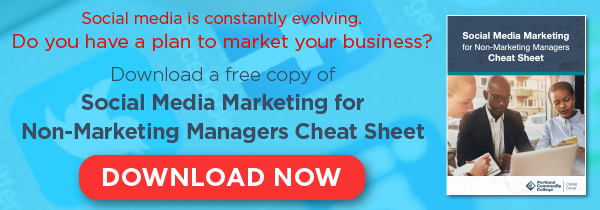 As a business owner, you may have wondered — should my business be using social media? The answer is yes! Small business and social media are a natural fit. Most small business owners understand the importance of social media and its potential to increase sales. Hubspot reports that 92% of small business owners surveyed indicated that social media marketing was important and 80% said that using social media helped them increase traffic to their website. Social media provides an opportunity to not only reach a broad audience but also engage with them and build relationships. Keep in mind, however, that the use of social media platforms varies according to specific demographics, such as age, gender, and income level. In this post, we’ll take a look at five of the most popular social media platforms for small business marketing and how you can use them for marketing your brand.
As a business owner, you may have wondered — should my business be using social media? The answer is yes! Small business and social media are a natural fit. Most small business owners understand the importance of social media and its potential to increase sales. Hubspot reports that 92% of small business owners surveyed indicated that social media marketing was important and 80% said that using social media helped them increase traffic to their website. Social media provides an opportunity to not only reach a broad audience but also engage with them and build relationships. Keep in mind, however, that the use of social media platforms varies according to specific demographics, such as age, gender, and income level. In this post, we’ll take a look at five of the most popular social media platforms for small business marketing and how you can use them for marketing your brand.
Facebook continues to be the most popular social media platform. 68% of all adult Americans use Facebook. 76% of them visit the site daily, and over half say they use the site several times a day. Users include men and women in nearly equal percentages across nearly all demographics — age, level of education and income, and geographic location. This makes Facebook an important platform for all types of small businesses.
The second most popular social media platform is Instagram. Approximately 32% of adult Americans have an Instagram account. It’s a particularly important platform for your business if your target demographic includes young adults, ages 18 to 29, 50% of whom are users of Instagram. The percentage of users in older age ranges decreases significantly starting at age 30; only 8% of those 65 and over reporting that they use Instagram. Use among women is slightly higher than for men. Most users have some college, 38% have annual incomes below $30,00, and 39% live in urban locations.
Twitter is used by roughly one-quarter of online adults. Similar to Instagram, Twitter use is concentrated mostly among those ages 18 to 29, with 36% in that age group having Twitter accounts, while only 10% of users are over the age of 65. Use is evenly split between men and women, as well as geographic location. 29% of users have a college degree, and 30% report an annual income of more than $75,000.
While LinkedIn lags behind Instagram and Twitter in terms of users — 29% of U.S. adults use the platform — it is particularly useful if your target audience includes college graduates and higher income earners. 50% of users have a college degree and 45% of them have an annual salary of $75,000 or more. The majority of users (64%) are located in urban or suburban areas, with only 18% residing in rural locations.
With an overall use of 31% among online adults, women overwhelmingly account for the majority of users, 45% compared to 17% of men. 36% of users are aged 18 to 29, but Americans of all ages use the platform, including 16% of those aged 65 or over. Most users (68%) have some college or a college degree, and users are fairly even split in terms of income brackets, with those earning $75,000 or more using the platform at a slightly higher rate (35%).
So, what does all this mean for your small business? Your social media presence should be guided by the demographics of your target audience. On Facebook, you have the ability to reach a wide range of potential customers across age groups and income levels, so it’s an important part of a small business social media strategy. Likewise, Twitter users are fairly evenly divided across demographics, though at a much lower overall level than Facebook. Other platforms allow you to reach a more narrow market segment. Instagram is an important way to target adults between the ages of 18 and 29 at lower income levels, while Twitter reaches the same age range but at higher levels of income. If your target audience is women, Pinterest is the place to be.
However, keep in mind that you should not limit your social media presence to only one or two platforms. Even if your target market is mostly senior citizens, for example, Facebook and Twitter are important, but in addition, LinkedIn and Pinterest represent significant opportunities to reach that age group. What’s important is that you have a solid understanding of your target market and consider multiple platforms to reach them in different ways on different social media sites.




